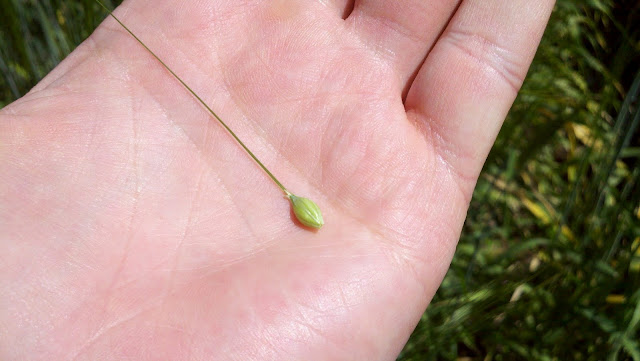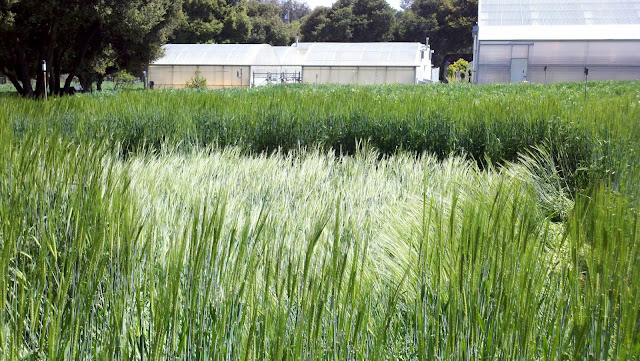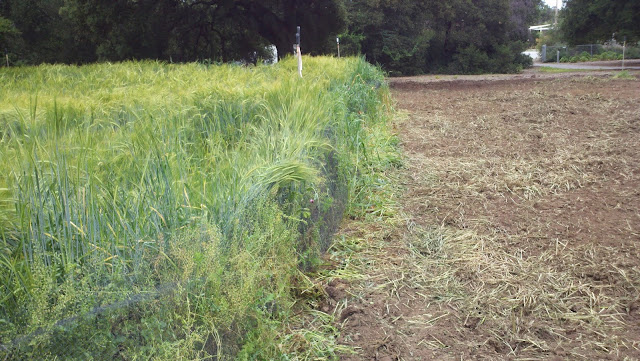I really need to figure out when my barley will be ready to harvest. I need an estimate to tell the corn people, because they need the field soon.
The answer depends on accurately assigning a stage to the developing grain heads. The information available on barley plant development is not great, and the info on kernel development is even worse, crappy even! Most extension websites will list the stages of growth but assume you already know what they mean.
I'm looking at you, Minnesota! Anyway, here's roughly what happens after heads emerge. Once the whole head is out, kernels begin flowering from the center of the head outward toward the bottom and top. Then, the grain grows from a small embryo at the bottom of the kernel to a full-length grain. This time of growth covers the stages from "watery ripe" to "milk"
Why those names? The defining feature of watery and milk stages is that when you crush the grain, a bunch of liquid comes out. The liquid is supposed to be clear in the beginning, and then become milky, hence the names. I noticed this change in liquid color, but I thought the grain growth was more significant.
Now, when I crush grains from my most advanced tillers, out comes a soft wet clump of starch, much like the jelly in the bottom of a bubble tea.

You can see that nasty-looking (but delicous -- you bet I ate it) thing, covered in a generous amount of milky liquid.
Despite the copious fluid, I believe this constitutes the transition from a "milk" stage to a "dough" stage, because the stuff is becoming solid.
Can anyone else comment on the kernel stage based on that photo?Here's another clue: the grains are becoming plump.

They still crush with a fingernail, but it's a huge change from the soft planty feel the heads have had until now. Getting plump seems to be the way to distinguish
late from
early soft dough kernels.
Here's yet another way to measure: GDD since heading. I noticed lots of awns appearing in an entry dated March 8. Since that date, there have been 563 GDD. It took Merit's kernels on the main stem (most advanced tiller), about the same amount of GDD,
537, to reach late soft dough stage.
Please set me straight if you know better, but I'm going to proceed assuming that I'm in late soft dough.
Now to predict the future: I can harvest once kernels reach physiological maturity, right after late hard, not soft, dough stage. Merit kernels were at
late hard dough at 1028 GDD after heading. I will hit this mark, according to weather.com's GDD predictor, on May 10. The next week, Merit was at the "kernel hard" stage of ripening, which is after the point when it's ok to harvest. This took 1284 GDD since heading, and I should reach that mark on May 22.
Friends, this is joyous news! If I'm right, at least some of the tillers will bear maltable grains between May 10 and May 22. The corn people need the field by "mid-May" so I'm calling May 22 close enough. Yes!
Now, it's a little more complicated than that, because most farmers stop irrigating sometime before the harvest. This, paradoxically, speeds maturity. Lynn Gallagher, malting barley breeder at UC Davis, explains:
As the late tillers die a certain percentage of the
photosynthate is re-mobilized and sent to stronger, earlier tillers. C14
studies have been done on this about 30 years ago. It is only natural that
when the water is cut off the late developing tillers die. Sometimes as
many as 50% of the total tiller number per plant may die and produce
nothing. If the planting density is optimal late tillers may not develop
because of shading. Usually but not always the maitre brin (MB) is the
strongest tiller - that is the main stem. T1 thru Tn usually become less
productive than MB.
To sum up, there is a tradeoff between yield and maturity date, and this tradeoff is controlled by available water. The U Idaho blog, for example, recommends stopping irrigation back in the early soft dough stage.
What to do? Well, it would not be worth the risk to try to increase yield by continuing to irrigate, only to end up with a bunch of underdeveloped and unmaltable grains come mid-May. There is still 9-11" of moist soil, which in my loamy clay is probably less than 2" of water (thanks to Ryan Pfeifle). It will be highs of 60's to 70's for the next week, so if those temps continue, I can expect my plants in soft dough to use
.1-.13" of water per day. That means there is 17 days of water in the field -- less if evaporation is higher in the top foot of soil as Ryan suggested, and more if the plants begin to use less water as they enter hard dough.
17 days of water in the ground -- I frankly have no idea what to do with that number. But I can at least say that I won't run out of water in the next week. Decision: I won't resume irrigation for now (it was already off because of last week's rain), and I'll see how the plants respond as the water is depleted. I really need those late tillers to die, so I'll be watching them carefully over the next week.
There we go. Feeling a bit more in control.














